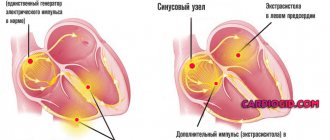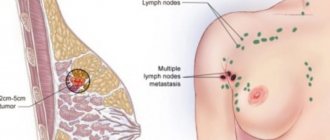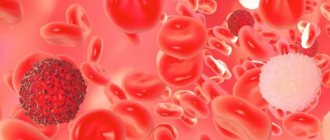Symptoms of ovarian cancer
Signs of ovarian cancer in the initial stage may be absent, or be so non-specific that the woman simply notices them, or treats other diseases.
At an early stage of pathology, women may complain:
- to mild, bursting pain;
- heaviness in the abdomen, especially in the lower part;
- periodic constipation.
With severe inflammation of the tissues surrounding the ovary or rupture of its capsule, a sharp, sudden pain pierces the body. If you have such symptoms, you should urgently visit a gynecologist or call an ambulance.
Caution: A ruptured ovarian capsule is a medical emergency. You can’t put a heating pad on your stomach or drink painkillers uncontrollably.
The accumulation of fluid in the abdominal cavity causes a bulge in the abdominal wall, which can lead to the formation of a hernia. Intestinal damage occurs:
- the intestinal lumen narrows;
- the absorption capacity of the villi decreases;
- the supply of nutrients decreases;
- The cells of the body experience starvation, which can cause death.
Important: In case of ovarian cancer, if the uterus is not involved in the process, there is no pathological discharge from the genital tract.
Despite the fact that the first signs of pathology are similar to other diseases, it is possible to detect cancer at this stage by undergoing a comprehensive examination: intravaginal examination, blood tests, ultrasound (at the very early stages, this study may not reveal pathology).
According to indications, some patients are prescribed laparoscopy or biopsy for histological analysis of the biomaterial taken.
Late stages are characterized by rapid tissue damage spreading throughout the abdominal organs. Women are concerned about symptoms such as:
- severe weakness, chronic fatigue;
- bloating, weak appetite;
- physical and mental exhaustion, depression;
- frequent urination;
- dyspnea.
Fluid that accumulates in the lower body cavity causes the abdominal wall to bulge, which can lead to the formation of a hernia. Intestinal damage occurs:
- the diameter of the intestines narrows;
- the absorption capacity of microvilli and villi decreases;
- body cells experience starvation, which is fraught with death.
Important: If the tumor has not touched the uterus, there is practically no discharge.
Forecast
The survival prognosis depends on factors such as the stage of cancer, the woman’s age, the presence of certain groups of diseases, the quality of medical therapy received, and psychological mood.
At the early stages of the development of the disease, there are still no metastases in the internal organs and lymph nodes. Therefore, the earlier the diagnosis is made and treatment begins, the greater the likelihood of recovery.
Important: The cure is considered complete when the patient remains alive for 5 years after therapy. But women still remain at risk. Lifelong remission can be complicated by ascites - the accumulation of fluid in the abdominal cavity promotes accelerated germination of cancer cells (metastases) to other organs.
Risk group
Women at risk include:
- those who have given birth late or have not given birth at all;
- using oral contraceptives correctly;
- are in menopause;
- over four and a half to five decades of age;
- with the early onset of the first menstrual cycle;
- long-term treatment for infertility;
- having gynecological diseases (presence of cysts, benign tumors);
- with a burdened heredity.
10% of all cases have a hereditary predisposition.
Caution: Not breastfeeding in the future may lead to the development of tumors.
Bad habits, prolonged contact with carcinogenic substances, poor diet and unfavorable environmental conditions also predispose to the development of cancer.
Causes
There are many reasons that can provoke the development of cancer. Serous carcinoma appears against the background of the influence of external factors and the state of the body.
If a patient suffers from dangerous pathologies, the risk of developing cancer increases significantly. The main reasons are as follows:
- weakened immune system;
- heredity;
- improper diet;
- presence of bad habits;
- obesity;
- hazardous working conditions;
- failures in the correct functioning of the thyroid gland;
- hormonal imbalance;
- ovarian pathologies;
- menopause;
- profuse bleeding;
- improper use of hormonal medications;
- abortions;
- surgical interventions on the genital organs.
Important! Heredity plays a huge role in the development of a malignant tumor.
Classification of ovarian cancer
Doctors distinguish several classifications: morphological, histological, stage, age. The American Joint Committee on Cancer uses the TNM system:
- T – primary tumor, its size;
- N – metastases in nearby lymph nodes;
- M – distant metastases.
Most oncologists and gynecologists additionally use the classification of the International Federation of Gynecologists and Obstetricians (FIGO):
- Stage I – the neoplasm is located within the ovaries.
- Stage II – the tumor extends beyond the pelvis.
- Stage III – the tumor grows into the abdominal cavity.
- Stage IV – metastases penetrate to distant organs
Precancerous diseases
Precancerous ovarian diseases are a common pathology. Its incidence is highest in women who have undergone gynecological operations for benign tumors of the reproductive organs and mammary glands.
Women with menstrual problems who are taking hormonal treatment to suppress ovarian function are at risk. Inflammatory processes in these organs provoke precancerous conditions.
Epithelial ovarian cancer
Ovarian epithelial tumors are generally considered secondary, as they develop from borderline or benign neoplasms or cysts. Cancer cells are located on the surface of the organ and grow slowly.
The prognosis is unfavorable because most often the disease is detected at a late stage. Primary cancer accounts for only 4-5%, but is clearly malignant. Treatment is only surgical, but even with carefully performed surgical intervention, relapses are observed.
Germ tumor
Germ cell tumor is a rare malignancy that occurs in children and young women. It is formed from germ cells that normally develop into the tissue of the yolk sac, placenta or fetus. Tumors grow very quickly, cause pain in the pelvic area, and therefore are quickly identified.
Treatment is only surgical - the damaged ovary is removed. Survival rate 5 years after treatment and chemotherapy is above 70%.
Stromal cell pathologies
Pathologies with a low degree of malignancy develop from germ cells of the sex cord. They are more common in the postmenopausal period, in women with increased hormonal activity. Capable of relapse. With an excess of testosterone, patients show signs of virilization or masculinization.
With an excess of estrogen, uterine bleeding is observed. Timely surgery and radiation therapy increases survival rate to 90%.
Metastatic ovarian tumors
A malignant neoplasm that occurs due to the spread of metastases to nearby organs - the gastrointestinal tract, mammary glands, lymphomas. Cancer cells penetrate the ovaries through the bloodstream or lymphatic vessels and develop into a tumor. Neoplasms grow quickly and reach large sizes.
Metastatic cancer is more common between the ages of 45-60 years. Treatment is surgical. In the postoperative period, chemotherapy, hormonal, and radiotherapy are prescribed. The prognosis is not always favorable.
What it is?
Ovarian carcinoma is characterized by localization in the stromal or parenchymal tissue of the appendages.
Its primary or secondary origin is distinguished.
Oncological disease is in second place in terms of prevalence.
The first position is occupied by malignant neoplasms in the uterine area.
The main cause of carcinoma is an ovarian cyst, which grows against the background of detachment of epithelial tissue. It is generally not possible to determine how a neoplasm begins to develop.
The disease occurs as a reaction to changes in the genetic material of cells. This makes them quite susceptible to the effects of carcinogenic factors. Normal function is impaired. Subsequent influence often leads to pathological changes in the form of a cancerous tumor, which contains atypical cells.
Stages of ovarian cancer
Clinically, the development of cancer is divided into four stages. Each stage is characterized by its own symptoms, survival prognosis, and treatment methods.
Stage 1
Signs characteristic of the first stage:
- the tumor is located within the ovary;
- no active growth of pathological tissues is observed;
- the capsule remains intact;
- the functioning of the bladder and gastrointestinal tract is disrupted.
During the course of the disease, the following subtypes can be distinguished:
- the tumor spreads only to one ovary and does not affect other organs (1A);
- the tumor affects the right and left ovary (1B);
- the pathological process covers not only the ovaries, but also the capsules, and metastases penetrate into the abdominal fluid (1C).
Symptoms of the disease
A woman is worried about a feeling of fullness, bloating, an increase in waist size, frequent urge to urinate, slight pain in the pelvic area, decreased appetite, and nausea. These symptoms at the first stage are not clearly expressed.
Treatment
The goal of treatment is to remove the uterus with appendages and ovaries to prevent the growth of malignant cells. Chemotherapy is required after surgery.
Survival prognosis
With the first stage of ovarian cancer, the prognosis is more favorable - up to 90% of women survive. But pathology is detected at this stage in only 20% of patients.
This is often due to the fact that a woman forgets to visit a gynecologist in a timely manner, or begins to self-medicate, feeling the “familiar” symptoms of more harmless diseases - cystitis, inflammation of the intestines or appendages, which she associates with hypothermia or poor nutrition.
Therefore, the answer to the question of how long people live with stage 1 ovarian cancer depends not only on doctors, but also on the patient.
Stage 2
Growing neoplasms further change the woman’s condition, affecting not only the ovaries, but also other organs.
Symptoms
The growing tumor puts pressure on the internal organs, causing unpleasant symptoms. Women complain:
- for increasing fatigue, sleep disturbance, fever;
- the appearance of bleeding;
- incomprehensible irritability, tearfulness, short temper;
- weight loss, but increase in abdominal volume.
Forecast
Since the second stage of ovarian cancer involves the uterus, fallopian tubes, bladder, and lower intestines, the prognosis is less favorable.
The survival rate is only 60-70%. There is a high risk of relapse - cancer cells that enter the abdominal cavity during ascites penetrate the lymph nodes and activate the process of damage to nearby organs.
Treatment
Treatment is surgical, followed by a course of adjuvant chemotherapy.
Adjuvant therapy is treatment with cytostatic drugs that destroy cancer cells remaining after surgery.
Stage 3
Women who forget to take care of their reproductive health and do not undergo medical examinations find out that they have a tumor at this stage.
Cancer affects one, often two ovaries, and affects groups of organs not only in the pelvic region, but also beyond. At this stage, the following subtypes are distinguished:
- small metastases are located in the abdominal cavity (A);
- the size of metastases grows up to 2 cm (B);
- tumor cells are located outside the abdominal cavity (C).
Symptoms
The manifestations of the pathology are so obvious that one cannot help but pay attention to them:
- rapid weight loss, exhaustion (cachexia);
- vomiting, severely swollen belly, frequent flatulence, dyspepsia;
- even with a small amount of food eaten, a feeling of fullness in the stomach;
- pain in the lumbar region, pelvis;
- pain during sexual intercourse;
- frequent urge to urinate:
- anemia develops.
Forecast
The survival rate for stage three cancer is very low, only 20-30%. Even small (up to 2 cm) metastases remaining after laparotomy can shorten a woman’s life by up to 3 years.
Stage 4
The fourth stage of cancer is practically uncurable. At this stage, the body's immune strength is low, so metastases spread very quickly throughout the body, penetrating through the lymph and bloodstream.
An increased number of cancer cells begins to actively produce growth factors, which leads to the growth of the capillary network. Blood vessels actively feed cancer cells, disrupting the functioning of healthy tissues and organs.
Symptoms
All symptoms of pathology that appeared earlier intensify. When metastases penetrate into the lungs, shortness of breath occurs. Metastases can be detected by palpation.
Important: In order not to wait for the development of stage 4 cancer, if incomprehensible symptoms appear, you must immediately undergo a full examination, make sure that the diagnosis is correct, and receive high-quality treatment. If drug therapy does not give the desired results, you need to undergo repeated consultations with specialists.
According to statistics, about 50% of women trigger the disease by self-medicating or suffer from an incorrect diagnosis.
Survival prognosis
The expected lifespan varies from person to person. The best prognosis is observed in young patients with high immunity, who have no chronic diseases, and who discovered the disease in its first stages. Life expectancy is significantly reduced with cancer in old age, its detection at stages 3-4, and the presence of poorly differentiated serous and other ovarian carcinomas.
Five-year survival forecast by stage:
- I – 60-95%;
- II – 40-60%;
- III – 10-20%;
- IV – 5-9%.
The more aggressive the tumor, the shorter the life expectancy. The prognosis is worst for serous ovarian carcinoma.
The likelihood of complete recovery and achieving a persistent relapse is determined by the timing of detection of adnexal carcinoma and the timeliness of treatment. To prevent the development of pathology, it is necessary to visit a gynecologist twice a year. This will prevent possible diseases of the genital area and help detect oncology in the first stages of development.
Diagnosis of ovarian cancer
Diagnosis (screening) of gynecological diseases begins during routine visits to the doctor. Includes visual, manual and instrumental examination.
Screening is a complex of medical tests prescribed to identify a particular pathology.
Inspection
The condition of the genital organs, rectum, and pelvis is assessed. A smear is necessarily taken from the cervix to identify tumor cells.
Ultrasound
Thanks to ultrasound, it is possible to determine the size of the tumor, determine its location, the degree of spread to neighboring areas, and characteristic signs. Ultrasound can be prescribed repeatedly, which is important for monitoring the dynamics of the tumor.
Echography
Transvaginal echography is prescribed to detect very small tumors.
CT scan
It is prescribed to determine the size of tumors, their spread and damage to other organs (liver, bladder, kidneys).
Radiography
X-ray of the lungs and stomach is necessary to exclude (or determine) metastases in the ovaries.
MRI
An informative study that can be used to determine the size of the tumor and the extent of the process. Contraindications to this study are metal implants in the body, mental illness.
Positron emission tomography
It is based on the introduction into the body of radioactively labeled glucose, which accumulates in the tumor. Helps detect minimal accumulations of malignant cells
Laparoscopy
An endoscope is inserted through a small incision in the peritoneum, transmitting an image to a monitor. The organs are examined, the degree of damage to the ovary is determined, and a biopsy is performed for further histological analysis.
Colonoscopy
It is often performed before surgery to assess the condition of the walls of the rectum, the presence or absence of metastases in it.
Tumor markers
The most reliable test for cancer cells is the CA 125 tumor marker. Can be used to monitor oncopathology. But screening at the first stage of ovarian cancer is practically not informative.
Differential diagnosis
Necessary to clarify the diagnosis. At the first stage, ovarian cancer does not have clear symptoms, so it is often confused with inflammation of the appendages, cystoma, fibroids, and uterine tuberculosis.
Reviews
Olga. At the age of 36, I was diagnosed with ovarian cancer. It was recommended to remove one ovary. I didn't agree. I decided to be treated with homeopathy. But after 2 years the entire uterus had to be removed. I really regret that I didn’t listen to the doctors.
Julia. I am grateful to those doctors who saved my life and gave me the opportunity to become a mother. I found out about my diagnosis by accident and went for an examination because I couldn’t get pregnant. The doctors operated on me, even saving part of one ovary. I completed 6 courses of chemotherapy. The main thing is to believe in yourself and trust the doctors.
Karina. My mother was diagnosed with stage 3 ovarian cancer at 56 years old. She was operated on. The uterus was removed. She underwent chemotherapy. But a few months later metastases were discovered in the liver. Mom was so mentally and physically exhausted that she refused treatment, despite persuasion. Although treatment wouldn't help either. Mom died. Fortunately, when she was in severe pain, we were given painkillers that kept her from suffering.
Ovarian cancer treatment
Main methods: surgical treatment, medication, chemotherapy, radiation therapy.
Surgery
Most doctors believe that surgery is the most effective method of solving the problem, regardless of the stage of cancer. The surgeon’s task is to select the most appropriate type of intervention and perform it efficiently.
Types of operations:
- Panhysterectomy – removal of the uterus with appendages and ovaries. The greater omentum is also removed, which may contain still invisible metastases.
- Extirpation. All genital organs are removed, along with the cervix.
- Cytoreductive surgery. Aimed at eliminating the tumor and reducing the number of cancer cells.
- Palliative surgery. It is prescribed for the disintegration of a neoplasm in order to remove the tumor and stop bleeding.
- Laparoscopy. Recommended for diagnostic purposes after surgery or treatment.
Chemotherapy
Often prescribed before surgery to shrink the size of a cancerous tumor and make it resectable. After removal of the affected organ, chemotherapy is necessary to eliminate cancer cells and metastases.
Radiation therapy
It is prescribed for radiation when surgery and chemotherapy are ineffective.
Treatment for relapse
With the third or fourth stage of cancer, relapses almost always occur. They are associated either with the penetration of cancer cells into healthy organs or with the low qualifications of the surgeon performing the operation. The main treatment methods prescribed for relapses:
- detoxification of the body;
- chemotherapy;
- palliative radiation;
- use of analgesics.
Is ovarian cancer curable in stage 4 women?
At this stage, the chances of survival are minimal, but they always exist. First of all, they are connected with the desire of the patient herself to fight for her life. Symptomatic therapy plays an important role in prolonging life.
Targeted therapy for ovarian cancer
Targeted therapy is the use of antibody-based pharmaceuticals. These drugs (Avastin, Bevacizumab) act on blood vessels, disrupting the supply of oxygen and nutrients to the tumor and leading to its death.
Hormone therapy
Some tumors increase their growth under the influence of certain hormones. To slow down the development of cancer cells, drugs are prescribed that suppress the production of these hormonal secretions. Treatment is often carried out in combination with chemotherapy.
Nutrition and diets for ovarian cancer
If you have ovarian cancer, you need to adhere to a nutritious, but at the same time, simple diet. The diet should include more fruits and vegetables. Heavy food that is difficult to digest in the stomach and intestines is not recommended. It is prohibited to consume alcohol, fried, smoked foods. It is better to steam, bake or stew food.
After undergoing chemotherapy or radiation, food preferences may change and appetite may decrease, so you should try to eat small portions of high-calorie foods. All nutritional recommendations can be obtained from your doctor.
FAQ
I am 56 years old, menopause for 5 years. Due to large fibroids and hyperplasia, it is proposed to remove not only the uterus, but also the appendages. This is explained by the risk of ovarian cancer. Is such extensive surgery necessary?
Considering age, menopausal experience and underlying diseases (fibroids, endometrial hyperplasia), this operation is very desirable. Ovarian cancer is possible after removal of the uterus. Since there have been no menstruation for several years, the absence of appendages will not cause unpleasant symptoms.
An ultrasound of my daughter (18 years old) revealed large formations in both ovaries and an increase in tumor markers. How high is the likelihood of cancer and is it possible to do without surgery?
Bilateral ovarian tumors always raise suspicion for cancer. In this case, there is a possibility of a malignant tumor. But it is possible that these are benign cysts, inflammatory changes in the fallopian tubes and other options. Tumor markers increase in all pathologies of the female genital organs. Therefore, to determine the type of tumor, surgery must be performed.
Ovarian cancer during pregnancy
If a pregnant woman is diagnosed with a malignant ovarian tumor, surgical treatment is necessary. It is advisable to perform the operation at 14-16 weeks. The decision to continue the pregnancy is made by doctors together with the patient after a thorough examination and determination of the degree of cancer.
In the first trimester, termination of pregnancy is recommended due to possible pathologies in the fetus. In the second trimester, the extent of surgical intervention depends on the clinical picture of the tumor and the wishes of the woman. In the third trimester, a cesarean section is performed, and then a full-fledged operation is performed.
Important: Before planning a pregnancy, it is necessary to conduct screening, donate blood for tumor markers, and undergo an ultrasound.
If a malignant tumor has affected one ovary, in order to preserve the possibility of pregnancy, the woman has the affected organ and omentum removed. After surgery, chemotherapy is given.
Ovarian cancer is a tumor lesion of the hormone-producing gonads. In the early stages there are practically no symptoms. Therefore, preventive examinations, high-quality examination and subsequent treatment increase the chances of possible motherhood and survival of the patient.
Observation after therapy
After completion of therapy, the woman should be under constant supervision of a gynecological oncologist. In the first 2 years you need to visit a doctor every three months, then a little less often, but regularly. To detect a relapse, an ultrasound is performed and CA-125 is determined in the blood. Sometimes six months before visible tumor progression, the CA-125 marker increases several times. But usually chemotherapy begins after confirmation of relapse on ultrasound or CT. This approach does not affect life expectancy and its quality.










